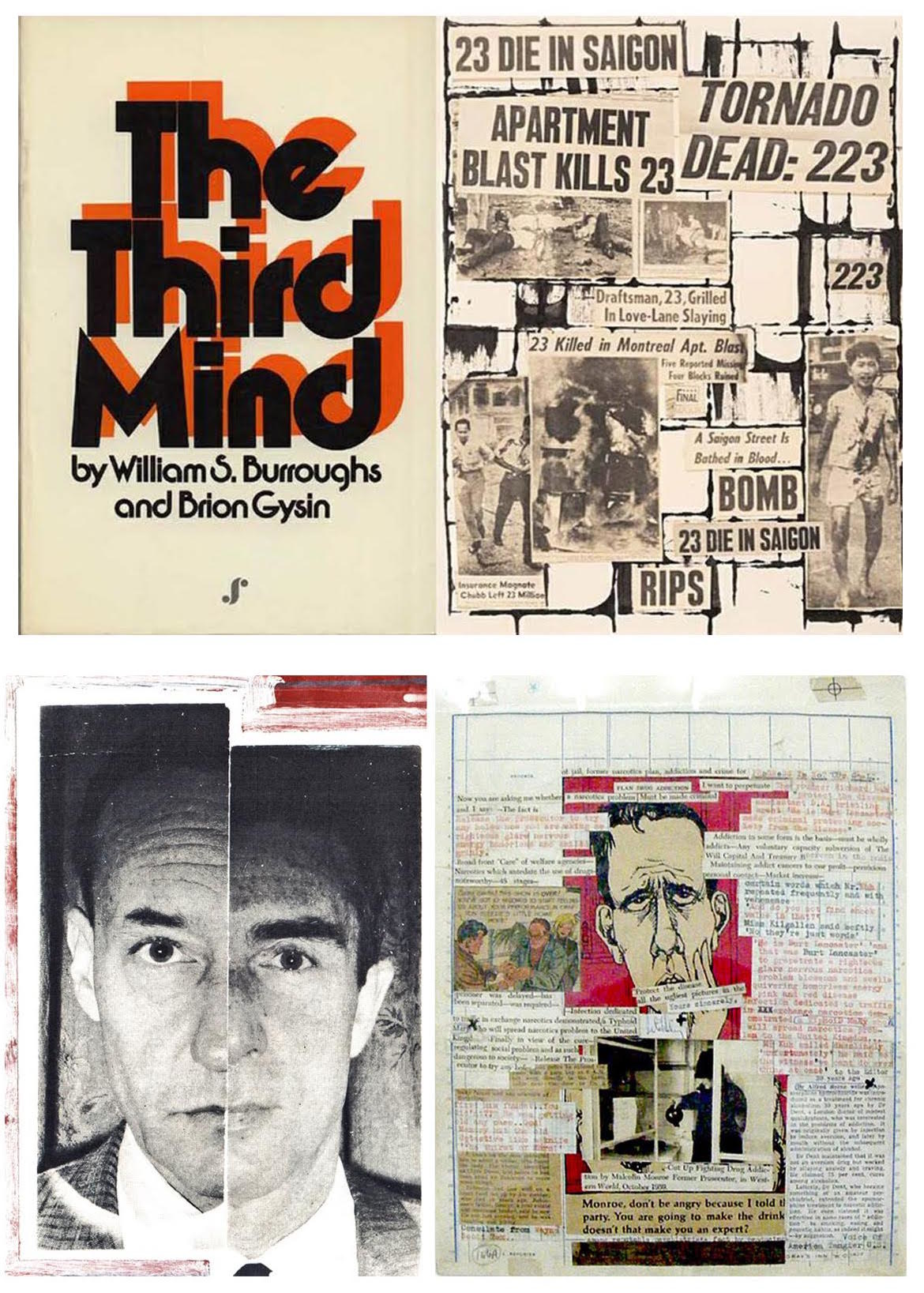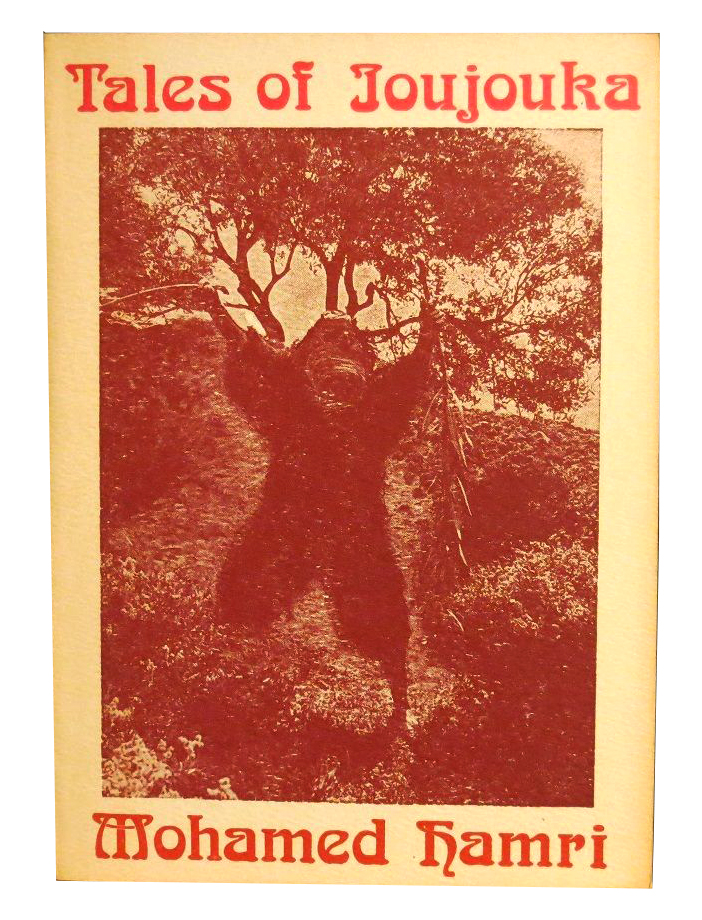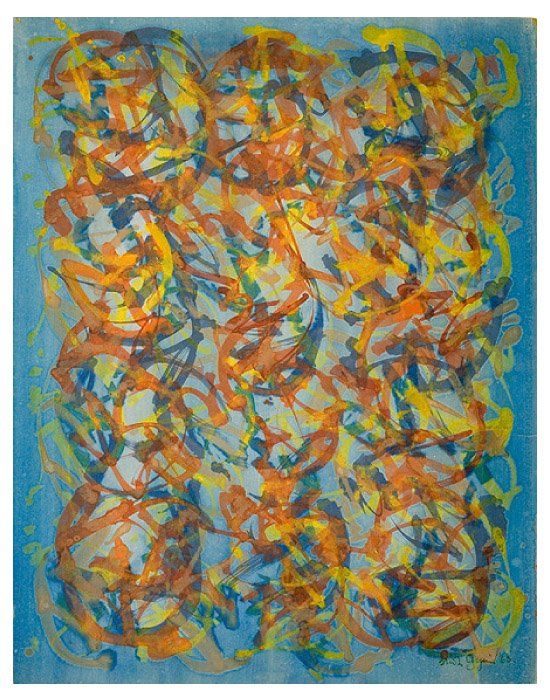brion gysin
︎Artist, Painting, Collage, Spirituality, Article
︎ Ventral Is Golden
brion gysin
︎Artist, Painting, Collage, Spirituality, Article
︎ Ventral Is Golden
︎ Ventral Is Golden
“Not knowing what is and is not knowing, I knew not.”




The renowned Beat Generation writer William Burroughs once said that Brion Gysin was the only man he ever respected.
After the two met in Tangier, Morocco in the early 1960’s, their artistic relationship burgeoned as their practices of the visual arts and literature merged, reviving the cut-up technique that popularised much of Burroughs’ writing and many more poets and musicians that followed the Beat Generation.
Gysin and Burroughs would later publish a collaborative novel, The Third Mind (1977), that acted as a manifesto of the possibilities of cutting up ‘junk’, surplus, printed ephemera, and newspaper articles, in order to disassociate the words from their engrained meanings. Something that Gysin believed to be the fundamental role of the poet and musician - to liberate words from their sentences and what Burroughs believed to be a form of divination, by ‘cutting into the present to let the future leak in’.
Gysin’s artistic output was vast and peripatetic, ranging from calligraphy, large scale floor paintings, sound poetry, video manipulation, creative writing, performance art and theatre.
From the late 1950s to the early 1960s, Gysin’s style manifested itself in a series of calligraphic paintings and esoteric drawings that he produced whilst living in Morocco.
Being fluent in written Arabic and Japanese, Gysin’s canvases of script represented an attempt to fuse writing and painting into a single complex of sensory sigilisation. His works were often constructed not only to impress the spatial enviornment of the printed word - the excesses of unnecessary speech patterns that permeate large urban environments, but also to address the magical elements of the written sign as a sigil - a symbol or magical element, abstract illuminations or glyphs that are charged by the organic desires arising from within or behind ‘the self’ who is speaking or writing them into existence.
He would take this interest further to reveal within the repetitive incantations of his Permutation Poems the magical propensity that semantics and euphony had upon reality.
His sound experiments and Permutation Poems, such as ‘I Am That I Am’ and ‘Junk is No Good Baby’ influenced poets like Gertrude Stein and Bob Dylan, where the operation of the poem would be to stretch the meaning of word combinations beyond their initial limitations. Embracing magnetic tape and computer technology, at a time when such a practice was the preserve of scientists and the military, Gysin equated his permuations with the cognitive effects of a mechanical feedback loop.
![]()
After the two met in Tangier, Morocco in the early 1960’s, their artistic relationship burgeoned as their practices of the visual arts and literature merged, reviving the cut-up technique that popularised much of Burroughs’ writing and many more poets and musicians that followed the Beat Generation.
Gysin and Burroughs would later publish a collaborative novel, The Third Mind (1977), that acted as a manifesto of the possibilities of cutting up ‘junk’, surplus, printed ephemera, and newspaper articles, in order to disassociate the words from their engrained meanings. Something that Gysin believed to be the fundamental role of the poet and musician - to liberate words from their sentences and what Burroughs believed to be a form of divination, by ‘cutting into the present to let the future leak in’.
Gysin’s artistic output was vast and peripatetic, ranging from calligraphy, large scale floor paintings, sound poetry, video manipulation, creative writing, performance art and theatre.
From the late 1950s to the early 1960s, Gysin’s style manifested itself in a series of calligraphic paintings and esoteric drawings that he produced whilst living in Morocco.
Being fluent in written Arabic and Japanese, Gysin’s canvases of script represented an attempt to fuse writing and painting into a single complex of sensory sigilisation. His works were often constructed not only to impress the spatial enviornment of the printed word - the excesses of unnecessary speech patterns that permeate large urban environments, but also to address the magical elements of the written sign as a sigil - a symbol or magical element, abstract illuminations or glyphs that are charged by the organic desires arising from within or behind ‘the self’ who is speaking or writing them into existence.
He would take this interest further to reveal within the repetitive incantations of his Permutation Poems the magical propensity that semantics and euphony had upon reality.
His sound experiments and Permutation Poems, such as ‘I Am That I Am’ and ‘Junk is No Good Baby’ influenced poets like Gertrude Stein and Bob Dylan, where the operation of the poem would be to stretch the meaning of word combinations beyond their initial limitations. Embracing magnetic tape and computer technology, at a time when such a practice was the preserve of scientists and the military, Gysin equated his permuations with the cognitive effects of a mechanical feedback loop.






“This was the first piece of art meant to be viewed with eyes closed, and was Gysin’s (unsuccessful) intention to sell the machine to Panasonic in order to eventually replace the television.”
Music was also a defining interest in Gysin’s works and became an intriguing aspect of his artistic output and experiments with sound, ritual and altered states. First to note was Gysin’s association with Ian Sommerville, a mathematician who worked with The Beatles and later on the fabrication of an invention called the Dream Machine.
The Dream Machine was a pioneering piece of hallucinatory kinetic art, constructed out of nothing more than a turntable that rotated at 78rpm, a cantilevered light and a cylinder with rounded parallelograms cut from its surface. The idea came to Gysin as he was falling asleep on a bus in Marseille. As the sun set amongst the trees, it created what he termed the ‘flicker’ effect, that induced a lucid dream state not too dissimilar from starring at flames. Later, with Sommerville, they would learn that the revolutions of the turntable could recreate this effect and correspond to the frequency of Alpha waves emitted by the brain during deep sleep.
The Dream Machine encouraged the loss of visual control, to become a single agency for the transmission of images, triggering the hidden genetic permutations of the psyche.
It was dubbed the first piece of art meant to be viewed with eyes closed, and was Gysin’s (unsuccessful) intention to sell the machine to Panasonic in order to eventually replace the television.


Secondly, whilst still living in Morocco, Gysin played an important role in introducing the Master musicians of Joujouka to Brian Jones, who would later visit and record the group in the small Moroccan village on July 29th 1968. Having initially being entranced by the ritualistic sound of their sufi folk music, Gysin, upon the invitation of Moroccan painter Mohamed Hamri, was able to view the ceremony that accompanied their transcendental music.
The ceremony itself consisted of dressing a young man as Bou Jeloud, the Goat God, wearing the skin of a freshly slaughtered goat, running to "spread panic through the darkened village" as the musicians played with abandon. This led Gysin to view the ritual as an early origin of the ancient Greek god Pan, from which the album took inspiration for its name. Gysin would also collaborate with Hamri on the LP design and wrote a detailed text that was included in the release (below).
The ceremony itself consisted of dressing a young man as Bou Jeloud, the Goat God, wearing the skin of a freshly slaughtered goat, running to "spread panic through the darkened village" as the musicians played with abandon. This led Gysin to view the ritual as an early origin of the ancient Greek god Pan, from which the album took inspiration for its name. Gysin would also collaborate with Hamri on the LP design and wrote a detailed text that was included in the release (below).


Through his esoteric interests, Gysin also partially came to believe that he was the reincarnation of the 11th century Persian scholar, mystic, ascetic and political revolutionary, Hassan-I-Sabbah.
Sabbah lived until the age of ninety and was widely known as The Old Man in the Mountain, where he strategically ruled from the Persian highlands for many years. He recruited wonderers and gypsies into his fortress at Alamut, subduing them with vast amounts of hashish. Once the travellers had awoken from their intoxication, Sabbah would recount with detail, their dream-like visions of a paradisical garden, which Sabbah had secretly hidden within the walls of Alamut, casting the illusion of his omnipotence. The effect of this initiation was so strong that Sabbah was able to rule large parts of Persia without ever having a military, instead creating one of the first known Orders of Hashshashins (the origin of the word Assassin).
This process of mind control was of particular interest to both Gysin and Burroughs during the early 60’s as the american government started to use hallucinogens on the public in covert operations that violated human rights, such as MK Ultra. At the same time corporations and media institutions became a dominat force of black magic used to sculpt public and political opinon across most industrially developed nations. For Burroughs, written language was always an alien virus who’s intent was to corrupt the mind of the individual, and this was a constant theme of his work. He went on to write a scathing prose poem called ‘The Last Words of Hassan-I-Sabbah’, where he condemns big business, public relations sectors of the press, the CIA and FBI for being manufactured with the intent to infect the language stream and thought processes within America and throughout the modern world.
“Listen to my last words, anywhere!
Listen all you boards, governments, syndicates, nations of the world,
And you, powers behind what filth deals consummated in what lavatory,
To take what is not yours,
To sell out your sons forever! To sell the ground from unborn feet
forever. For Eve - are.
Listen to my last words, any world!...”
.
Sabbah lived until the age of ninety and was widely known as The Old Man in the Mountain, where he strategically ruled from the Persian highlands for many years. He recruited wonderers and gypsies into his fortress at Alamut, subduing them with vast amounts of hashish. Once the travellers had awoken from their intoxication, Sabbah would recount with detail, their dream-like visions of a paradisical garden, which Sabbah had secretly hidden within the walls of Alamut, casting the illusion of his omnipotence. The effect of this initiation was so strong that Sabbah was able to rule large parts of Persia without ever having a military, instead creating one of the first known Orders of Hashshashins (the origin of the word Assassin).
This process of mind control was of particular interest to both Gysin and Burroughs during the early 60’s as the american government started to use hallucinogens on the public in covert operations that violated human rights, such as MK Ultra. At the same time corporations and media institutions became a dominat force of black magic used to sculpt public and political opinon across most industrially developed nations. For Burroughs, written language was always an alien virus who’s intent was to corrupt the mind of the individual, and this was a constant theme of his work. He went on to write a scathing prose poem called ‘The Last Words of Hassan-I-Sabbah’, where he condemns big business, public relations sectors of the press, the CIA and FBI for being manufactured with the intent to infect the language stream and thought processes within America and throughout the modern world.
“Listen to my last words, anywhere!
Listen all you boards, governments, syndicates, nations of the world,
And you, powers behind what filth deals consummated in what lavatory,
To take what is not yours,
To sell out your sons forever! To sell the ground from unborn feet
forever. For Eve - are.
Listen to my last words, any world!...”
.


︎Recordings from Gysin’s The 1001 club in Tangier.
The supposed last words of Hassan-I-Sabbah, as recounted by Burroughs and Gysin, were “Nothing is True, Everything is Permitted”, and were used as the title for Brion Gysin’s biography. It has also been suggested that this epithet was adopted by Gysin throughout his life in relation to the difficulties he faced with understanding his own identity. Sometimes stating that his life was “a tale I am telling myself”, which, through the spelling, re-spelling, and mis-spelling of his own name, gave him some autonomy within the world but also resigned him to being what he described as a ‘terminal tourist’.
This view of himself drove Gysin excessively towards relationships of sound and form, particularly to a time before the technology of the written word had become mechanised enough to fix itself to the sensory world of the poet in material terms.
This oscillation between magical and practical diciplines is why language played such an important role in Gysin’s work. His use of grids is an obvious dance between language, urbanisation and folk magic, particularly the talismanic squares of eastern mysticism and the geometric importance of Kabbalistic symbology. Gysin often wrote in Arabic from right to left and in Japanese from top to bottom, rotating his canvas as he wrote so language dissolved backwards into a seething mass of primal intent. If the word truly contained the potency of creation, as the source of all philosophies claimed, then it could be revealed within the dissolution of technical language.
In Tangier during the 1960’s, after being Inspired by the extraordinary feats of fire walking, levitation and shape-shifting demonstrated by the holy berber marabouts of Joujouka, Gysin and Burroughs attempted to raise the spirit of an Egyptian mage named Abramelin. The Book of Abramelin supposedly dates to the 1700’s with the first printed copy being found in Cologne, Germany. The magical square is a prominent feature of Abramelin‘s magic and functions in a similar way to the Sator Square pictured on the front cover of the english translation.
One of Abramelin‘s squares is an instruction on how to walk and breathe underwater and contains the Hebrew word ‘MAIAM’.
For Gysin this square must have been of particular interest as it echoed his own permutated mantra of ‘I Am That I am. Am I That Am I?’.
Although a footnote to the Beat Generation, Brion Gysin’s influence can be felt throughout the art world to this day, and his intimacy with the occult origins of communication became the stroboscopic seed of counter-cultural, consciousness expanding, palindromic flashbulb orgasm that summoned the eternal pan-incarnate panacea of the poet’s soft machine through the music of visual language.
![]()
![]()
This view of himself drove Gysin excessively towards relationships of sound and form, particularly to a time before the technology of the written word had become mechanised enough to fix itself to the sensory world of the poet in material terms.
This oscillation between magical and practical diciplines is why language played such an important role in Gysin’s work. His use of grids is an obvious dance between language, urbanisation and folk magic, particularly the talismanic squares of eastern mysticism and the geometric importance of Kabbalistic symbology. Gysin often wrote in Arabic from right to left and in Japanese from top to bottom, rotating his canvas as he wrote so language dissolved backwards into a seething mass of primal intent. If the word truly contained the potency of creation, as the source of all philosophies claimed, then it could be revealed within the dissolution of technical language.
In Tangier during the 1960’s, after being Inspired by the extraordinary feats of fire walking, levitation and shape-shifting demonstrated by the holy berber marabouts of Joujouka, Gysin and Burroughs attempted to raise the spirit of an Egyptian mage named Abramelin. The Book of Abramelin supposedly dates to the 1700’s with the first printed copy being found in Cologne, Germany. The magical square is a prominent feature of Abramelin‘s magic and functions in a similar way to the Sator Square pictured on the front cover of the english translation.
One of Abramelin‘s squares is an instruction on how to walk and breathe underwater and contains the Hebrew word ‘MAIAM’.
For Gysin this square must have been of particular interest as it echoed his own permutated mantra of ‘I Am That I am. Am I That Am I?’.
Although a footnote to the Beat Generation, Brion Gysin’s influence can be felt throughout the art world to this day, and his intimacy with the occult origins of communication became the stroboscopic seed of counter-cultural, consciousness expanding, palindromic flashbulb orgasm that summoned the eternal pan-incarnate panacea of the poet’s soft machine through the music of visual language.


“Writing is fifty years behind painting. I propose to apply the painters’ techniques to writing; things as simple and immediate as collage or montage. Cut right through the pages of any book or newsprint… lengthwise, for example, and shuffle the columns of text. Put them together at hazard and read the newly constituted message. Do it for yourself. Use any system which suggests itself to you. Take your own words or the words said to be “the very own words” of anyone else living or dead. You’ll soon see that words don’t belong to anyone. Words have a vitality of their own and you or anybody else can make them gush into action.”

︎The Book of Abramelin the Mage.


︎Tetragrammaton of Eliphas Levi.

︎Tetragrammaton.


︎Amazigh (Berber) talismans.




Further Reading ︎
The Third Mind, pdf, UBU Web
A Trip from Here to There, article
The Idea Machine, The White Review, article
Last Words of Hassan-i-Sabbah, William Burroughs, Poem recording
Flicker, Full Documentary on the Dream Machine and the art of Brion Gysin
Junk and Baboon from Gysin's album, ‘Self Portrait Jumping’.